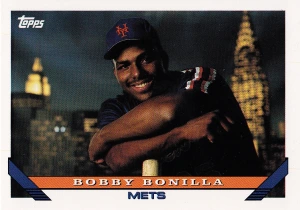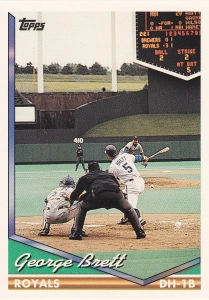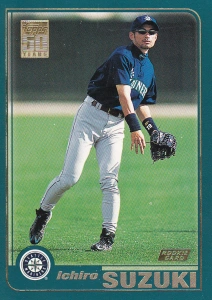As mentioned, the 1995 Traded set was the first that was sold exclusively in packs – no factory set was available. It’s also the largest Traded set to date, at 165 cards. One thing I found interesting – there’s no mention of replacement players anywhere on here. The card companies didn’t want to tick off the MLBPA, I guess.
There’s one member of the ’90 Reds in this set – that would be Joe Oliver, who signed as a free agent with Milwaukee in the offseason.
There’s one Hall of Famer with a base card in the set – that would be 2010 inductee Andre Dawson. The Hawk doesn’t have a card in the 1995 Topps set, so it was good they got him in this one. This card actually is one I still need – I got 1 in the box, but this one was pretty much ruined. It’s hard to tell from the scan, but it looks like Dawson has glitter falling down from his batting helmet as he swings here.
There are also 5 other Hall of Famers in the subsets of this set – Boggs, Ripken, Ozzie, Gwynn and Puckett. These guys were all featured in the All-Star subset near the end of the set. These 9 cards feature elected starters (I think) from each league for the ’95 All-Star game. Looking through this subset – there are a TON of guys who are future Hall-of-Famers, so some day I’ll have to update this list. Also interesting in this subset – Nomo-mania was in full swing for this set. He started the All-Star game as a rookie that year.
The other subset with big names in there is at the front of the set – cards #1-10 are the “At the Break” subset cards. These are also some big names. This subset covers how some players were doing at the time of the All-Star Break – even if its Griffey Jr., who got hurt early in the year and missed the majority of the first half.
The other subset out there was Rookie of the Year Candidates. This subset is actually found throughout the set – it’s not consecutively numbered. Some of these guys didn’t have other cards in the Traded set (like Chipper), but some did (Nomo and Tyler Green). Topps got both the winners in here – Nomo and Mary Cordova of Minnesota.
Though it’s not like Ripken from ’82, there are some decent rookie names in this set. Topps included Draft Picks in the Traded set for the second straight year – in the same design as the ’94 Draft Picks in the regular set. They also had the designs for “On Deck”, “Star Track” and “Prospects” cards. The most notable of the rookies is the Juan LeBron / Carlos Beltran Draft Pick snafu. The card considered Beltran’s “rookie card” features a picture of the other top Kansas City draft pick – LeBron. Meanwhile, LeBron’s card features a photo of the future All-Star, Beltran. Future Red Bronson Arroyo was also part of that draft class. After Andy Pettitte had an On Deck card in the regular set, fellow “core 4” member Mariano Rivera had his first Topps cards in this format in the Traded set. Nomo’s rookie card is the only Star Track card in the Traded set, and Richie Sexson is in the Prospects set.
There were also some big name free agents in this set. Larry Walker signed as a Free Agent with the Rockies in the ’94 offseason; he’d go on to what is a Hall of Fame worthy career in Colorado and the 1997 NL MVP. Ken Caminiti was part of a huge traded by Houston to San Diego after 6 full seasons and parts of two others – he’d win the 1996 NL MVP. And John Wetteland is often credited as helping to get the Yankees over the hump and finally winning the World Series. He also left Montreal as a free agent in the offseason and would win the Rolaids Relief Award in 1996 after leading the league in saves. He also saved all 4 Yankee wins in the 1996 World Series – their first title in nearly two decades.
There were also some other big name free agents as well. David Cone probably deserves to be in the group above – he was the reigning Cy Young winner at the time and would win 18 games in his second stint with Toronto in ’95 and still had a 20-win season and a perfect game ahead of him. Steve Finley was part of that big SD-HOU trade that Caminiti was in; he certainly had some excellent seasons in his future and would go on to become one of only 7 guys with 300 homers and 300 stolen bases. After he left Montreal, Grissom was never quite the same as a base stealing threat, but he helped three clubs to the World Series in each of the next 3 years – Atlanta in ’95 and ’96 and Cleveland in ’97.
Like any other Traded set – you have some older veterans who were getting to their last go round.
Finally, I’ll end it with my favorite couple photo shots. Benny Santiago decked out in catcher’s gear and one of my favorite Reds uniforms of all time, and some dude from Detroit in the aftermath of a play at the plate.




















































